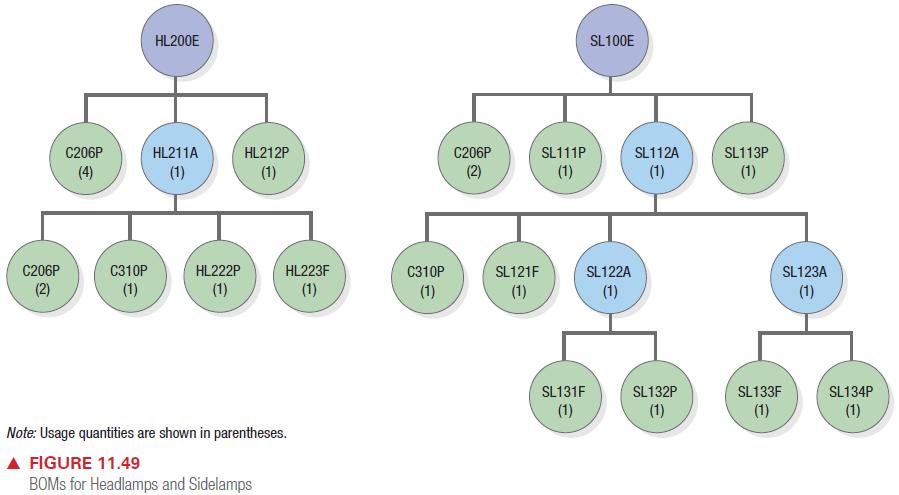Wolverine, Inc. is a medium-sized firm employing 900 persons and 125 managerial and administrative personnel. The firm
Question:
Wolverine, Inc. is a medium-sized firm employing 900 persons and 125 managerial and administrative personnel. The firm produces a line of automotive electrical components. It supplies about 95 auto parts stores and several car dealers in its region. Johnny Bennett, who serves as the president, founded the company by producing cable assemblies in his garage. By working hard, delivering consistent product quality, and by providing good customer service, he expanded his business to produce a variety of electrical components. Bennett's commitment to customer service is so strong that his company motto, "Love Thy Customers as Thyself," is etched on a big cast-iron plaque under his giant oil portrait in the building's front lobby. The company's two most profitable products are the automotive front sidelamp and the headlamp. With the rising popularity of Eurosport sedans, Wolverine has enjoyed substantial demand for these two lamp items. Last year, Kathryn Marley, the vice president of operations and supply chain management, approved the installation of a new MRP system. It is a first important step toward the eventual goal of a full-fledged ERP system. Marley worked closely with the task force that was created to bring MRP online. She frequently attended the training sessions for selected employees, emphasizing how MRP should help Wolverine secure a better competitive edge. A year later, the MRP system is working fairly well. However, Marley believes that there is always a better way and seeks to continually improve the company's processes. To get a better sense for potential improvements, she met with the production and inventory control manager, the shop supervisor, and the purchasing manager. Here are some of their observations. Production and Inventory Control Manager Inventory records and BOM files are accurate and well maintained. Inventory transactions are faithfully made when inventory is replenished or removed from the stockroom so that current on-hand balances are credible. There is an MRP explosion each week, which gives the company the new MRP. It provides information that helps identify when new orders need to be launched. Information can also be searched to help identify which scheduled receipts need to be expedited and which ones can be delayed by assigning them a later due date, thereby making room for more urgent jobs. One planner suggested that the MRP outputs should be extended to provide priority and capacity reports, with pointers as to which items need their attention. The original plan was to get the order-launching capability implemented first. However, there is no formal system of priority planning, other than the initial due date assigned to each scheduled receipt when it is released, transforming it from a planned order release into a scheduled receipt. The due dates do not get updated later even when there are unexpected scrap losses, capacity shortages, short shipments, or last-minute changes in the MPS (responding to requests from favorite customers). Jobs are scheduled on the shop floor and by suppliers according to the EDD rule, based on their due dates. If due dates assigned to scheduled receipts were updated, it might help get open orders done when they are really needed.
Furthermore, planned order releases in the action bucket are translated into scheduled receipts (using inventory transactions), after checking that its components are available. The current system does not consider possible capacity problems when releasing new orders. Shop Supervisor His primary complaint is that the shop workloads are anything but level. One week, they hardly have any work, and the supervisor overproduces (more than called for by the scheduled receipts) just to keep everyone busy. The next week can be just the opposite-so many new orders with short fuses that almost everyone needed to work overtime or else the scheduled receipt quantities are reduced to cover immediate needs. It is feast or famine, unless they make things work on the shop floor! They do make inventory transactions to report deviations from plan for the scheduled receipts, but these "overrides" make the scheduled receipt information in the MRP records more uncertain for the planners. A particular concern is to make sure that the bottleneck workstations are kept busy. Purchasing Buyers are putting out too many fires, leaving little time for creative buying.
In such cases, their time is spent following up on orders that are required in the very near future or that are even late. Sometimes, the MRP plan shows planned order releases for purchased items that that are needed almost immediately, not allowing for the planned lead time. In checking the MRP records, the planned lead times are realistic and what the suppliers expect. Last week, things were fine for an item, and this week a rush order needs to be placed.
What is the problem? Marley tried to assimilate all this information. She decided to collect all the required information about the sidelamps and headlamps (shown in Tables 11.23 through 11.26 and in Figure 11.49) to gain further insight into possible problems and identify areas for improvement.
Your Assignment Put yourself in Marley's place and prepare a report on your findings.
Specifically, you are required to do a manual MRP explosion for the sidelamps and headlamps for the next 6 weeks (beginning with the current week). Assume that it is now the start of week 1. Fill in the planned order releases form provided in Table 11.27. It should show the planned order releases for all items for the next 6 weeks. Include it in your report.
Supplement your report with worksheets on the manual MRP explosion, and list the actions that planners should consider this week to
(1) Release new orders,
(2) Expedite scheduled receipts,
(3) Delay a scheduled receipt's due date. Finally, identify the good and bad points of MRP implementation at Wolverine. Conclude by making suggestions on ways to improve its resource planning process.



Step by Step Answer:

Operations Management Processes And Supply Chains
ISBN: 9781292409863
13th Global Edition
Authors: Lee Krajewski, Naresh Malhotra, Larry Ritzman





